Water potential the complete researcher guide
Everything you need to know about measuring water potential—what it is, why you need it, how to measure it, method comparisons. Plus see it in action using soil moisture release curves.
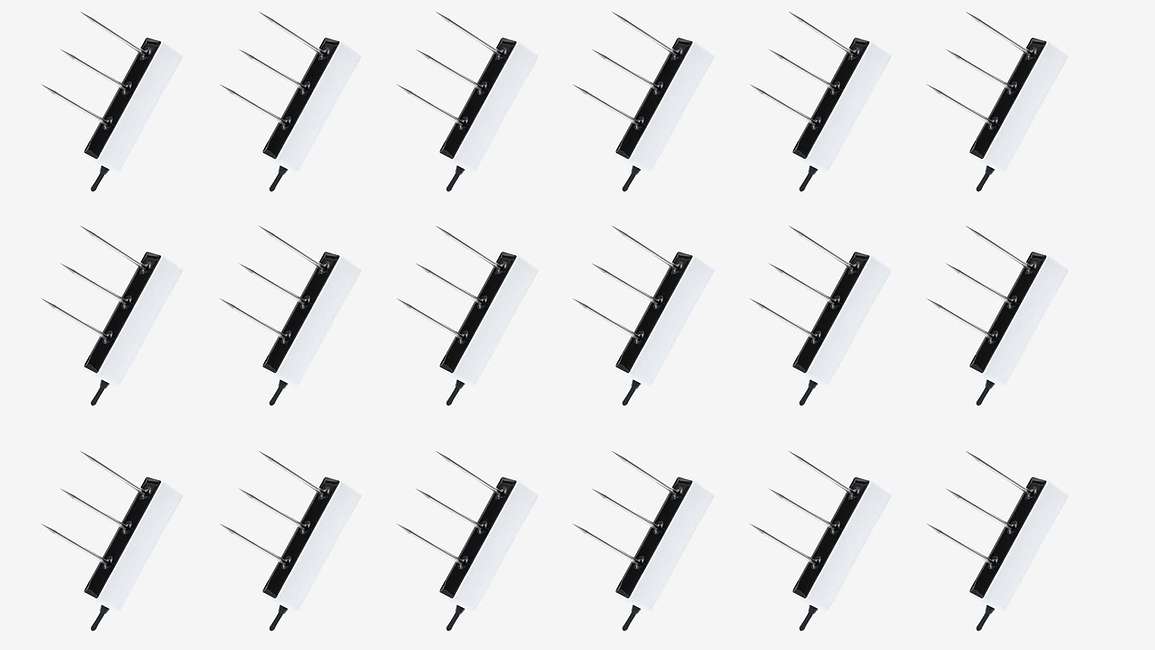
Mismanagement of salt applied during irrigation ultimately reduces production—drastically in many cases. Irrigating incorrectly also increases water cost and the energy used to apply it. Understanding the salt balance in the soil and knowing the leaching fraction, or the amount of extra irrigation water that must be applied to maintain acceptable root zone salinity is critical to every irrigation manager’s success. Yet monitoring soil salinity is often poorly understood.
In the webinar below, world-renowned soil physicist Dr. Gaylon Campbell teaches the fundamentals of measuring soil electrical conductivity (EC) and how to use a tool that few people think about—but is absolutely essential for maintaining crop yield and profit. Learn:
Irrigated land accounts for 40% of our food supply, and salts impact yields on about one-fifth of those acres. All irrigation water contains at least some salt. If salts are allowed to build up around the root zone of a crop, they injure plants, reduce yields, and even change soil structure causing long-term damage to the land itself. In order to preserve the productivity of irrigated land, it is important to understand how to manage salts.
The steps to managing salts are:
Electrical conductivity (EC) is the key to making these measurements. Pure water does not conduct electricity, but most water, even tap water, has enough dissolved salts to be conductive. Because the concentration of salts in water directly affects its conductivity, the measurement of electrical conductivity is a very effective way of measuring salt concentrations in soil water.
Most people have had the experience of fertilizing too heavily, perhaps by accident, and killing grass or other plants. It is often said that the fertilizer has “burned” the plants, but generally, it isn’t the nutrients themselves that cause the damage. It’s often their effect on water. Plants take up water, but they don’t take up salts in any appreciable quantity. When salt is added to the soil through fertilization and irrigation, it becomes concentrated there. Salt may cause a variety of problems for plants. For instance, Na+ may reach concentrations that are toxic to plants, even though the plant isn’t taking up any appreciable quantity. Salt also attracts water and makes it more difficult for plants to take up water from the soil. Some plants are more sensitive than others to salt in the soil. Bean yield will be affected if soil saturation extract EC exceeds 2 dS/m, for example, while barley can be grown without yield reduction in soil saturation extract up to 16 dS/m. Ultimately, however, high salt content will affect all plants.
| Sensitive | Moderately Tolerant | Highly Tolerant |
|---|---|---|
| Red clover | Wheat | Date palm |
| Pea | Tomato | Barley |
| Bean | Corn | Sugar beet |
| Pear | Alfalfa | Cotton |
| Orange | Potato | Spinach |
Table 1. Salt tolerance in crops
The SI unit for electrical conductance is the Siemen, so electrical conductivity has units of S/m. Units used in older literature are mho/cm (mho is the reciprocal of ohm). Soil EC was commonly reported in mmho/cm. 1 mmho/cm equals 1 mS/cm, but because SI discourages the use of submultiples in the denominator, this unit is changed to deciSiemen per meter (dS/m), which is numerically equivalent to mmho/cm or mS/cm.
| USDA Class | Saturation Extract (dS/m) | Salt in Soil (g salt/100g soil) | Osmotic Potential (kPa) | Crop Tolerance | Example Crops |
|---|---|---|---|---|---|
| A | 0-2 | 0-0.13 | 0 to -70 | Sensitive | Bean |
| B | 2-4 | 0.13-0.26 | -70 to -140 | Moderately sensitive | Corn |
| C | 4-8 | 0.26-0.51 | -140 to -280 | Moderately sensitive | Wheat |
| D | 8-16 | 0.51-1.02 | -280 to -560 | Tolerant | Barley |
Table 2. Salinity classes for soils (Richards, L.A. [Ed]. 1954. Diagnosis and Improvement of Saline and Alkali Soils, USDA AG Handbook 60, Washington DC)
There are three ways to measure EC in soils: measuring pore water EC, bulk EC, or saturation extract EC. All three are related, but there are tools to convert one into the other. In order to understand measurement data, it is important to know what type of EC is being measured.
Pore water EC or soil water EC (σw) is the electrical conductivity of the water in the soil pores. Researchers often mistake the value coming out of a soil EC sensor for pore water EC. It would be ideal to simply measure the electrical conductivity of pore water in situ. Try to imagine how this would work, however. Tiny sensors would have to be inserted into microscopic water-filled pores. Obviously, it’s not possible to measure the EC of water on that scale. In fact, the only way to measure pore water EC is by extracting a soil water sample and measuring the EC of that sample.
Bulk EC (σb) is the electrical conductivity of the bulk soil (soil, water, and air). Soil moisture sensors installed into the soil all measure bulk EC. Empirical or theoretical equations can be used to determine pore water EC and saturation extract EC (σe) from measured bulk EC values. Bulk EC is the only EC measure that can be continuously monitored in situ.
Saturation extract EC (σe) tells exactly how much salt is in the soil and can be converted to soil salinity. This is the traditional way to measure EC. It is measured by taking a soil sample, making a saturated paste of soil and deionized water, extracting the water, and then measuring the EC of the extracted solution. Published EC values reported in the literature are almost always saturation extract EC.
As stated previously, in situ sensors measure the electrical conductivity of the bulk soil surrounding the sensors (σb). A considerable amount of research has been conducted to determine the relationship between σb and the conductivity of the pore water (σw). Hilhorst (2000) has taken advantage of the linear relationship between the soil bulk dielectric permittivity (εb) and σw to allow conversion from σb to σw if εb is known. The TEROS 12 sensors measure εb and σb nearly simultaneously in the same soil volume. They are well suited to this method. The pore water conductivity can be determined from (see Hilhorst, 2000 for derivation)

where σw is the pore water electrical conductivity (dS/m); εw is the real portion of the dielectric permittivity of the soil pore water (unitless); σb is the bulk electrical conductivity, (dS/m), which is measured directly by the sensor; εb is the real portion of the dielectric permittivity of the bulk soil (unitless); εσb=0 is the real portion of the dielectric permittivity when σb = 0 (unitless). εw (Equation 2) has a value of around 80. A more accurate value can be calculated from soil temperature using

where Tsoil is the soil temperature (ºC) measured by a temperature sensor colocated with the bulk EC measurement, as is common with METER soil EC sensors.
εb is also measured by most research-grade volumetric water content sensors.
Finally, εσb=0 is an offset term loosely representing the dielectric permittivity of the soil when the EC=0. Hilhorst (2000) recommended that εσb=0= 4.1 be used as a generic offset. Hilhorst (2000) offers a simple and easy method for determining εσb=0 for individual soil types, which will improve the accuracy of the calculation of σw in most cases.
Our testing indicates that the above method for calculating σwresults in fair accuracy (± 20%) in soils and other growth media at high water content (above 25%). As water content decreases, the denominator of Equation 1 becomes small, leading to large potential errors in the calculation. For best results, we recommend using the Hilhorst equation when water content is high to obtain saturation extract EC (σe) and then computing the pore water EC at lower (below 25%) water content assuming that the salt stays in the soil while the water is being removed (shown in Equation 3). Using this assumption

Where θ is the volumetric water content of the soil and θs is the water content at saturation, which can be computed from the bulk density of the soil

ρb is the bulk density of the soil (Mg/m3) and ρs is the density of solids (2.65 Mg/m3 for mineral soil).
EC of the saturation extract (often shown as ECe or σe) is the electrical conductivity of pore water removed from a saturated paste of the soil. The soil is wetted with distilled water until the soil saturates. Then the soil is placed on filter paper in a vacuum funnel, and suction is applied. An electrical conductivity measurement on the water removed from the sample will give σe. The σeof a soil is the value used for almost all salinity recommendations (see, for example, Richards, 1954) and is, therefore, an important value to obtain. It can be computed from the pore water EC using the following equation

Combining Equations 1 and 4 give

Equation 6 is likely to be the most useful equation for assessing salinity in the field. Again, use it when water contents are highest to maximize accuracy.
As an example, assume the bulk density of our soil is 1.33 Mg/m3. From Equation 4 this would give a saturation water content of 1 – 1.33/2.65 = 0.5. Assume we have measured a bulk EC of 0.3 dS/m when the water content is 0.345 m3/m3, and bulk dielectric (εb) = 20. The σe would be

Calculating pore water EC from bulk EC is not the same as converting from one set of units to another—it’s actually a model. Or rather, it’s many different types of models. Some are empirical, some are theoretical, but all have their own strengths and weaknesses. We’ve presented the Hilhorst model, but there are other popular models, including the Rhodes model and the Mualem and Friedman model.
| Saturation Extract EC | Soil Bulk EC | Pore Water EC | |
|---|---|---|---|
| Definition | The electrical conductivity of a solution of water extracted from a saturated soil sample | The combined electrical conductivity of the soil, air, and water in porous soil substrate | The electrical conductivity of the solution contained in the soil pores |
| Applications | Field agriculture applications for salt management | Any time continuous measurements are needed. Used for calculating pore water and saturation extract EC. | Greenhouse and nursery applications, leaching fraction calculations |
| Benefits | Quantitative measure of the amount of salts in the soil (soil salinity)
Best measure for determining crop suitability for a particular soil |
Can be measured continuously with an in situ probe
Value can be used in conjunction with volumetric water content to model saturation extract EC or pore water EC |
Measures what the plant is actually experiencing
Quantifies how much salt is being transported by drainage water |
| How Parameter is Measured
*All methods assume temperature-corrected EC values (All METER EC sensors contain this correction: see user’s manual) |
A soil sample taken from the field and mixed with deionized water until saturated. Then water is extracted out through a filter, and the EC and temperature of the water are measured with an EC meter
The value is calculated from bulk EC and volumetric water content measurements |
For electrical conductivity, sensor is placed in the soil at the desired depth | Soil pore water sampler is used to extract pore water from the soil at a specific depth. An EC meter is used to measure the EC of the water.
The value is calculated from bulk EC and volumetric water content measurements Value is determined from EC of Drain Gauge Lysimeter sensor, where soil pore water is collected and monitored |
Table 3. Methods for measuring different types of EC
One of the most common reasons for measuring EC in soils is to minimize salt in the root zones of actively growing plants. If the EC in the root zone becomes too high, a grower can add additional irrigation water to leach salts below the root zone. The illustration below demonstrates how, on a relative basis, saturation extract values might compare to one another with a lighter color indicating lower saturation extract EC and a darker color indicating higher saturation extract EC.
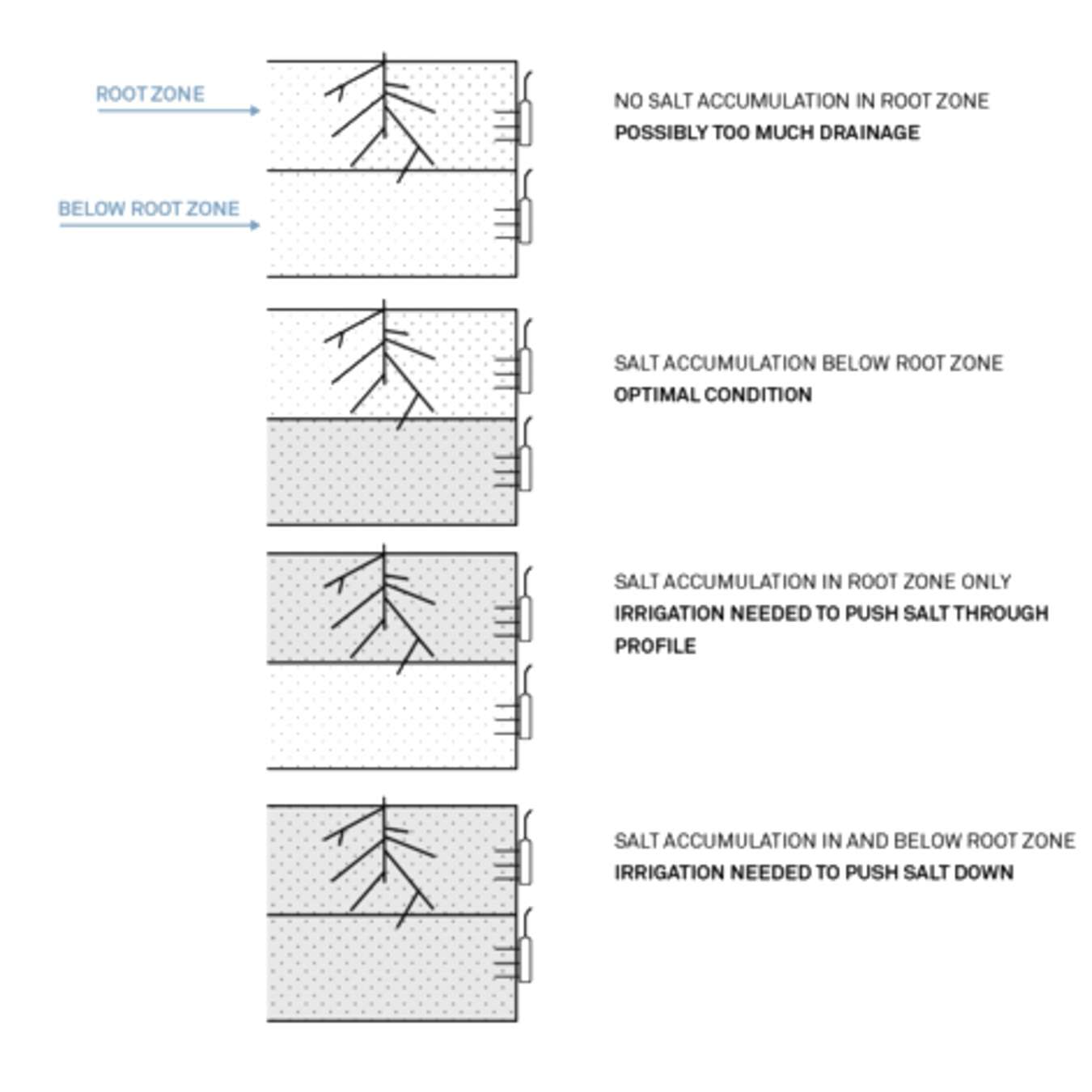
Leaching fraction (LF) is defined as the depth of water draining out of the bottom of the root zone (Ddrain) divided by the depth of water applied (through irrigation and precipitation) to the soil profile (Dapplied).
Use leaching fraction to compute how much water needs to run through the profile to maintain a particular electrical conductivity in the root zone.

For example, if the EC of liquid irrigation water were 0.3 dS/m, and the water draining past the root zone should have an EC of no more than 3 dS/m, irrigators should run a tenth of the applied water through the profile.
All this assumes, however, that drainage (how much water is draining out the bottom of the root zone) is accurately measured. In practice, this is a very difficult thing to measure. An innovative approach is to turn the leaching fraction equations around and use the EC of the drainage water to calculate deep drainage. The EC of drainage water can be measured by installing probes below the root zone.
Rearranging the equations, depth of drainage water is equal to the depth of water applied, multiplied by the EC of the applied water (precipitation and irrigation), divided by the EC of the drainage water.

In most areas, rain—which doesn’t contain salts—will play a significant role in overall salt balance. A good way to adjust the EC of the applied water (ECapplied) for the contribution of rain is to multiply the EC of the irrigation water times the depth of irrigation and divide by the depth of the rain plus the depth of irrigation.

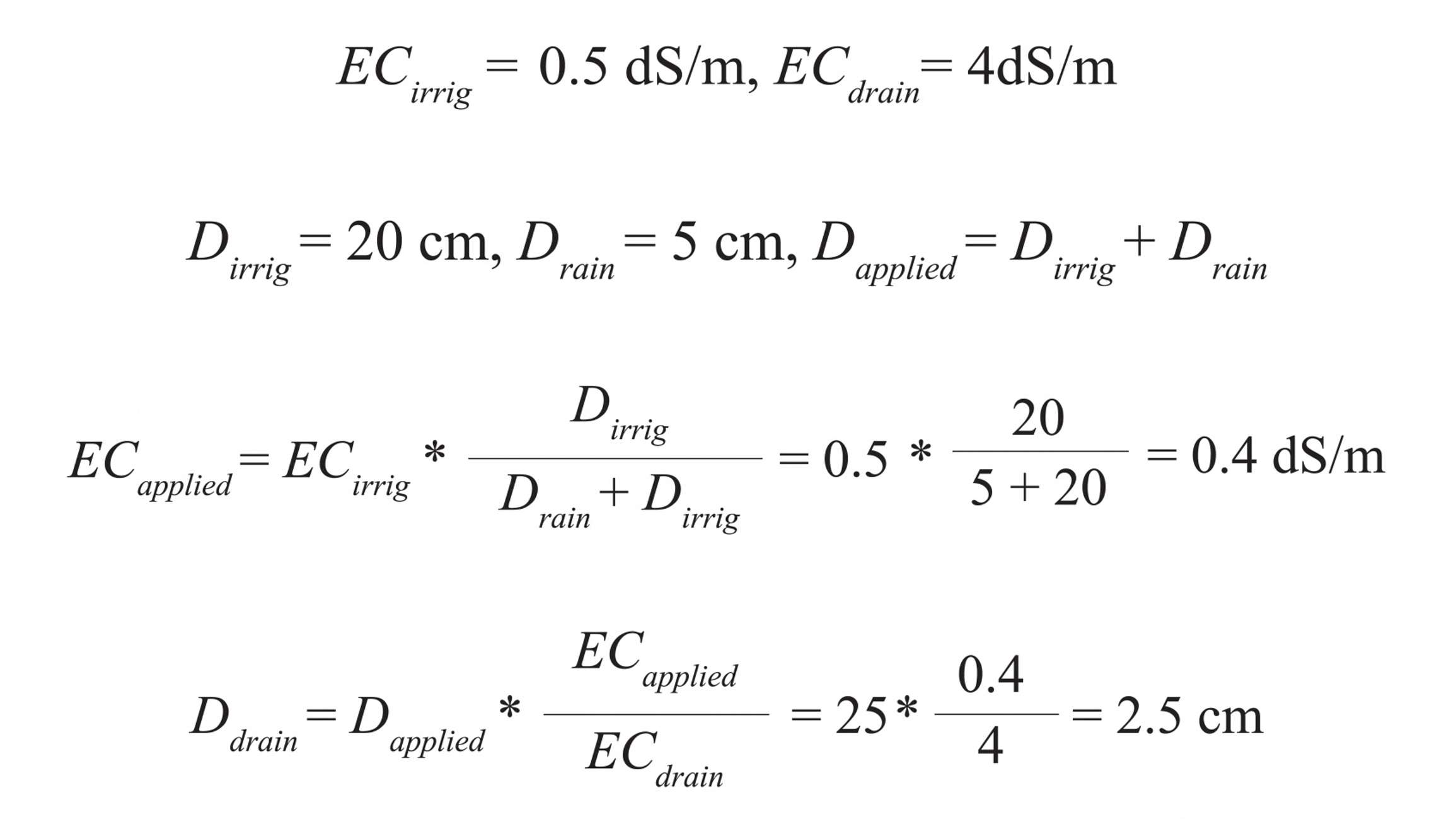
Leaching fraction is 0.4/4 which is 10%. The total water lost from drainage is 2.5 cm.
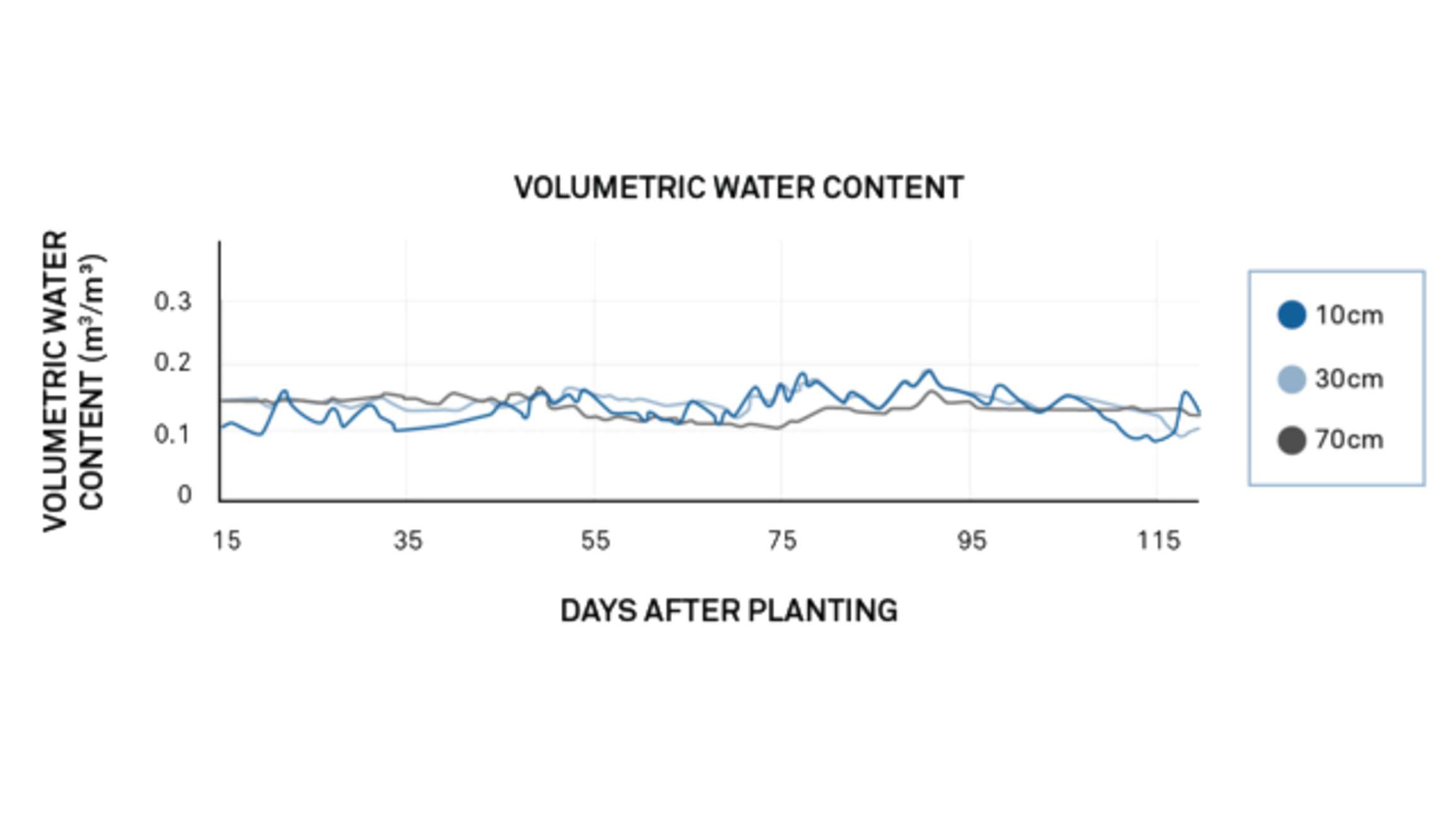
Figure 2 shows soil water content values at three depths over time, immediately following fertilization. But where is the fertilizer? Soil moisture values give no indication of nutrient leaching or drainage
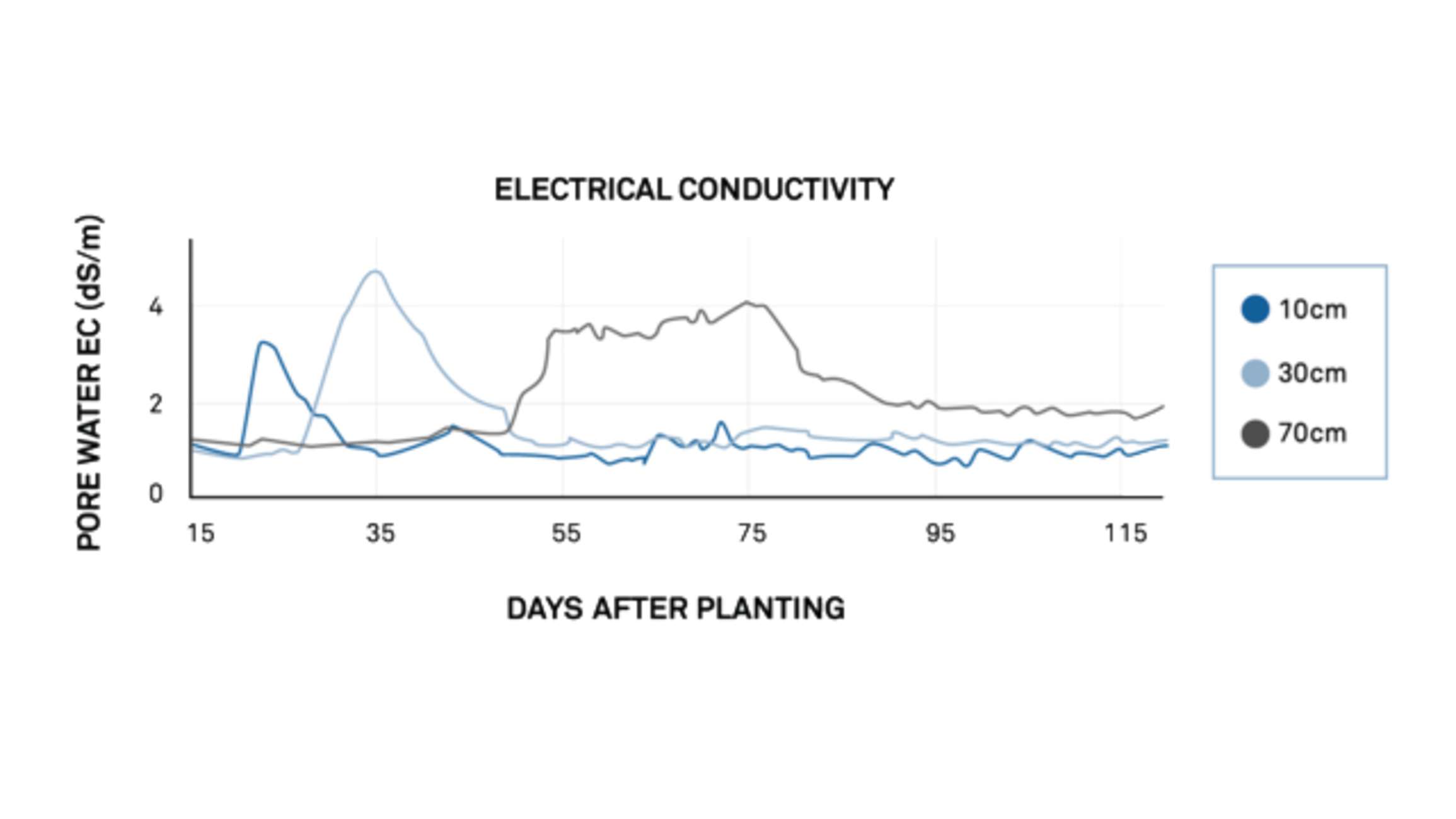
In Figure 3, measurements of bulk EC and volumetric water content from a GS3 were used to calculate pore water EC at the same three depths. Note how the fertilizer stays in the root zone temporarily but is leached out with water draining from the root zone. Both charts are taken from Stirzaker (2010).
The following sensors will allow you to gather data for specific EC models and applications.
5TE, GS3, TEROS 12
These soil moisture sensors can be used to determine:
G3 Drain Gauge and CTD + DG (EC/temp/depth sensor)
The G3 and the HYDROS 21 + DG can be used to determine pore water EC of soil drainage water (σw,ECdrain) when installed below root zone. Also, pore water samplers can be used to determine pore water EC (σw).
ES-2 temperature and EC sensor
The ES-2 can be used to determine EC of irrigation water (σw, ECirrig) when installed inline in the irrigation pipe (this requires a custom calibration).
Rain gauge
The rain gauge can be used to determine depth of rain (Drain).
Badger flow meter
This instrument can be used to determine depth of irrigation ((Dirrig) provided you know the total area being irrigated.
Hamed, Yasser, Magnus Persson, and Ronny Berndtsson. “Soil solution electrical conductivity measurements using different dielectric techniques.” Soil Science Society of America Journal 67, no. 4 (2003): 1071-1078. (Article link)
Hilhorst, Max A. “A pore water conductivity sensor.” Soil Science Society of America Journal 64, no. 6 (2000): 1922-1925. (Article link)
Mualem, Y., and S. P. Friedman. “Theoretical prediction of electrical conductivity in saturated and unsaturated soil.” Water Resources Research 27, no. 10 (1991): 2771-2777. (Article link)
Rhoades, J. D., P. A. C. Raats and R. J. Prather. “Effects of liquid-phase electrical conductivity, water content and surface conductivity on bulk soil electrical conductivity.” Soil Science Society of America Journal 40 (1976): 651-655.
Rhoades, J. D., N. A. Manteghi, P. J. Shouse, and W. J. Alves. “Soil electrical conductivity and soil salinity: New formulations and calibrations.” Soil Science Society of America Journal , no. 2 (1989): 433-439. (Article link)
Soil moisture is more than just knowing the amount of water in soil. Learn basic principles you need to know before deciding how to measure it. In this 20-minute webinar, discover:
Learn everything you need to know about measuring soil moisture—all in one place: why you need it, how to measure it, method/sensor comparisons, how many measurements, where you should measure, best practices, data troubleshooting, and more.
Six short videos teach you everything you need to know about soil water content and soil water potential—and why you should measure them together. Plus, master the basics of soil hydraulic conductivity.
Our scientists have decades of experience helping researchers and growers measure the soil-plant-atmosphere continuum.
Everything you need to know about measuring water potential—what it is, why you need it, how to measure it, method comparisons. Plus see it in action using soil moisture release curves.
Everything you need to know about measuring soil moisture—all in one place.
Irrigation management simplified. Perfect water and nutrient management without losing time and money to issues caused by over irrigation.

Receive the latest content on a regular basis.